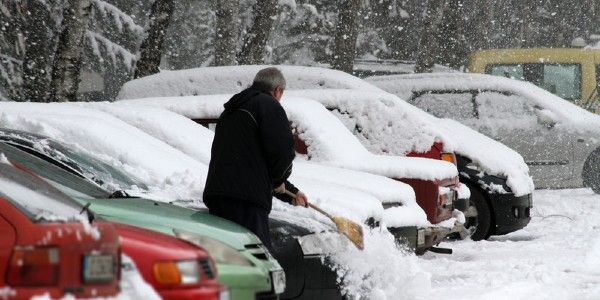Bad Weather - Driving in Snow and Ice

First thing to ask yourself when its icy or snowing, is your journey really neccesary?
Starting off in snow - If you experience wheel spin when trying to move off in deep snow, dont race the engine, because the wheels will dig deeper into the snow. Try and move the car slightly backwards and then forwards out of the rut. Use as high a gear as possible. In these conditons its worth carrying a small spade/shovel or some old sacks to put under the wheels to help your wheels get some traction in the snow.
Snow chains are also available, these can be fitted over existing wheels and tyres to help avoid getting stuck and to reduce the danger of skidding.
Driving in Snow - When falling snow reduces visability, use your dipped headlights as you would in heavy rain or fog. Falling or freshly fallen snow may not cause too much difficulty, providing you remember to
- increase the gap between you and the vehicle in front, remembering to look in your mirrors before slowing down
- test your brakes, very gently, from time to time, but be sure to look in your mirrors before braking. Snow can pack behind the front wheels or around brake linkages under the car and so affect steering and braking
- be prepared to clear the windscreen by hand. Your wipers, even with the aid of the heater, may not be able to sweep the snow clear. Snow might collect and pack around your lights and indicators
- drive with care, even if the roads have been treated. Conditions can change over very short distances
- try to find out about weather and traffic conditions ahead by listening to travel bulletins on the radio and noting any information on the variable message signs.
In an area subjected to long periods of snow, it may be an advantage to fit snow chains, socks, or mud and snow tyres with a tread pattern designed for these conditions.
Snow will cover up road markings and road signs - be careful when you can not see who has priority at a junction.
Driving in icy conditions - Overnight freezing can result in a dangerous icy surface to the road and footpaths, especially on less frequently used roads and paths. Look for signs of frost on verges etc. Its even more dangerous when roads are just starting to freeze or thaw. The combination of water and ice ads up to an extremely slippery surface.
Rain freezing on road as it falls (black ice) is an invisible danger, if you skid on black ice it will have a similar effect as aquaplaning and your steering will feel very light. Remember to keep your speed down when driving on ice and be very delicate with the controls of the vehicle.
If its very cold, treat all wet surfaces as though they are frozen, because the probably are. If the road looks wet but there is no sound from the tyres, expect ice.
